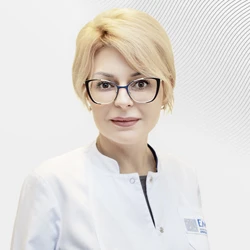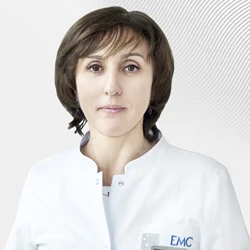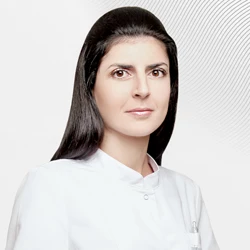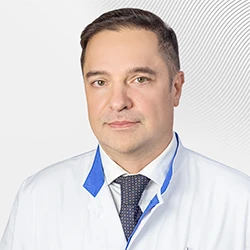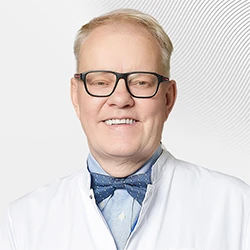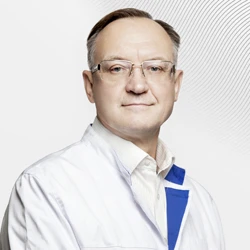Non-Hodgkin's lymphoma
 Non—Hodgkin's lymphoma is a type of tumor diseases of the lymphatic system characterized by irreversible proliferation of malignant lymphoid tissue cells.
Non—Hodgkin's lymphoma is a type of tumor diseases of the lymphatic system characterized by irreversible proliferation of malignant lymphoid tissue cells.
What is non-Hodgkin's lymphoma
Non—Hodgkin's lymphoma (NHL) is a broad term that combines a variety of subtypes of tumors that differ in their clinical, morphological, and genetic characteristics.
NHL occurs when a mutation occurs in lymphoid cells. They begin to divide uncontrollably and form tumors in various parts of the body. NHL occurs in tissues and organs containing lymphoid tissue, including lymph nodes, bone marrow, spleen, thymus, and others.
Causes of the disease and risk factors
The exact causes of non-Hodgkin's lymphoma are still not fully known. However, research and clinical experience can identify factors that increase the risk of developing the disease. Here are the main ones:
-
Heredity. Genetic mutations and abnormalities in the cells of the lymphatic system may play a role in the occurrence of NHL.
-
Weakened immune system. People with weakened immune systems are at increased risk of developing non-Hodgkin's lymphoma. For example, these are people after organ transplantation, HIV-infected people receiving immunosuppressive therapy.
-
Autoimmune diseases (rheumatoid arthritis, Hashimoto's thyroiditis, Sjogren's syndrome). With such pathologies, the functioning of the immune system is disrupted, which also becomes a risk factor for the NHL.
-
Viral diseases. Some viruses (Epstein-Barr, hepatitis C) are associated with the development of certain subtypes of NHL. These viruses affect the function of the lymphatic system, contributing to the development of the tumor process.
-
Environment. Prolonged exposure to certain chemicals (e.g. pesticides, solvents, insecticides) increases the risk of developing the disease. The same applies to other dangerous effects on the body: radiation, chemotherapy, radiation, and immunosuppressive therapy.
-
Age and gender. The risk of developing NHL increases with age, with most cases diagnosed in people over the age of 60. Men are also more susceptible to the disease.
The presence of one or more risk factors does not guarantee the development of the NHL. They can only increase the likelihood of a tumor.
Symptoms
Non-Hodgkin's lymphoma is manifested by various symptoms that depend on the type and location of the tumor. Here are the most common signs of the NHL:
-
Enlarged lymph nodes, usually in the armpit or groin area. This is the most common symptom. Lymph nodes may become visible or palpable on palpation.
-
Fatigue and weakness, even with little physical exertion.
-
Increased body temperature. This is a sign of inflammation or disease progression.
-
Weight loss for no apparent reason. This symptom is especially characteristic of the later stages of the disease.
-
Night sweating, itchy skin.
-
Systemic symptoms. Patients may also experience malaise, discomfort, difficulty breathing, coughing, or palpitations.
-
Pain syndrome. Pain in the abdomen, back, chest, when the lymph nodes increase in size and compression occurs.
The symptoms are non-specific and may indicate other diseases. However, if there are such signs, it is recommended to consult a doctor for diagnosis.
Classification of the disease
Non—Hodgkin's lymphoma is a group of diverse diseases that differ in cell type and growth pattern. There are several classification systems.
Classification by cell type:
-
B-cell lymphoma. The most common type occurs in 9 out of 10 patients. The tumor arises from B-lymphocytes− cells of the immune system responsible for the formation of antibodies. This category includes many subtypes: diffuse B-large cell lymphoma (DLBCL), follicular lymphoma (FL), Burkitt's lymphoma, MALT lymphoma, mantle lymphoma and small cell lymphocytic, among others.
-
T-cell lymphoma. This type develops from T-lymphocytes and makes up a small part of lymphoproliferative diseases. It also includes various subtypes: peripheral T-cell lymphoma, cutaneous T-cell lymphoma, and others.
According to another classification, lymphomas are divided into indolent (low-grade) and aggressive (highly differentiated). The tumor of the first type grows very slowly and does not always need treatment, sometimes it is enough to monitor the pathology. The aggressive type develops very quickly and requires immediate therapy.
The type of NHL is important for determining the prognosis and choosing an effective treatment strategy. Given the complexity of the classification, only a specialist can accurately determine the type and stage of the disease.
Diagnostics
Diagnosis of NHL is usually carried out in a comprehensive manner and includes collecting the patient's medical history, physical examination, laboratory and instrumental studies. The main method is a biopsy, that is, taking a tissue sample for analysis. Most often, the affected lymph nodes are examined. It is also possible to delete them simultaneously.
When the disease is diagnosed, additional methods are used to assess the stage of NHL and the prevalence of malignant cells in the body. Oncologists use:
-
laboratory tests, including modern diagnostic methods such as immunohistochemistry, immunophenotyping, and mutation detection;
-
CT, PET scan/CT;
-
MRI scan;
-
bone marrow biopsy;
-
spinal tap.
These diagnostic methods allow doctors to determine the type and stage of the disease, as well as plan further treatment, taking into account the patient's health characteristics.
Treatment
The main methods of NHL treatment are chemotherapy and targeted treatment. It involves the use of anticancer drugs that destroy cancer cells or prevent their growth and reproduction. Chemotherapy can be performed in the form of monochemotherapy (one drug) or combined chemotherapy (several drugs at the same time). Medications are administered intravenously or used in tablet form. Treatment is often performed on an outpatient basis, with regular follow-up examinations.
Chemotherapy is also used in combination with monoclonal antibodies. They have the ability to "recognize" specific proteins on the surface of cancer cells and integrate into the protein structure. Next, the body's immune system is triggered, which begins to attack cancer cells, and sometimes causes them to self-destruct.
In some cases, intrathecal chemotherapy is required. The method is used when there is a risk of lymphoma cells entering the brain, or if this has already happened. The drug is injected into the spinal canal or intravenously.
Another treatment method is stem cell transplantation. This is a procedure in which healthy stem cells are injected into the patient. They enter the bone marrow and begin to form new cells, replacing the damaged ones. This method is used if the patient does not respond to standard chemotherapy, as well as to treat relapses.
Radiation therapy is also used as the main type of treatment or in combination. This method is indicated for patients in whom NHL is localized in only one group of lymph nodes.
Complications
Non-Hodgkin's lymphoma can cause various complications, both on its own and as a result of treatment. Here are some of the unpleasant consequences associated with this disease:
-
Weakened immune system. Some types of non-Hodgkin's lymphoma reduce the functioning of the immune system, making the patient more susceptible to infections and other diseases.
-
Compression of organs. It occurs in large tumors. Depending on the location, compression of the esophagus and trachea, vena cava compression syndrome, intestinal obstruction, jaundice and other pathological conditions are possible.
-
Side effects of treatment: hair loss, fatigue, digestive problems. These symptoms are usually temporary and can be corrected with appropriate medical procedures.
-
Relapses. The NHL may return after the completion of treatment.
Following the recommendations of doctors will help to control and manage the complications of this disease.
Prognosis and prevention
The prognosis for patients with non-Hodgkin's lymphoma depends on the type and stage of the disease, the general condition of the patient, concomitant pathologies, age, and other indicators. Modern diagnostic and treatment methods make it possible to achieve the recovery of many patients, especially with early detection and the use of modern therapeutic approaches. There are also recurrent forms of the disease.
For those who have already been treated with NHL, preventive measures are important to maintain overall health and reduce the risk of recurrence or the development of other complications. There are no specific measures here. It is recommended to lead a healthy lifestyle and undergo regular routine checkups to identify early signs of disease recurrence.
At the EMC multidisciplinary clinic, we work according to international protocols, using high-quality original chemotherapy drugs and modern approaches to the treatment and rehabilitation of patients. If you are concerned about unpleasant symptoms, make an appointment for a consultation to be diagnosed and begin treatment.
List of sources and literature
- Tumyan G.S. Non-Hodgkin's lymphomas // Clinical oncohematology. 2015. №4. cyberleninka.ru
- Doronin V. A. Non-Hodgkin's lymphomas // Clinical oncohematology. 2008. №1. cyberleninka.ru
- Maloney DG. Non-Hodgkin's lymphoma. Curr Opin Hematol. 1995 Jul;2(4):255-61. doi: 10.1097/00062752-199502040-00004. PMID: 9372005.
- Smith MR. Non-Hodgkin's lymphoma. Curr Probl Cancer. 1996 Jan-Feb;20(1):6-77. doi: 10.1016/s0147-0272(96)80303-5. PMID: 8919170.
- Bilodeau BA, Fessele KL. Non-Hodgkin's lymphoma. Semin Oncol Nurs. 1998 Nov;14(4):273-83. doi: 10.1016/s0749-2081(98)80005-3. PMID: 9839340.
Why the EMC
The first and only clinic in Russia, created in the image of the world's leading clinics
EMC is a multidisciplinary center offering patients a high level of medical services and a personalized approach
Worldwide recognition and awards
 Learn more
Learn more
Worldwide recognition and awards
 Certificates and licenses
Certificates and licenses
Make an appointment for a consultation
Specify your contacts and we will contact you to clarify the details
Reviews
and new products of the EMC



.webp)







